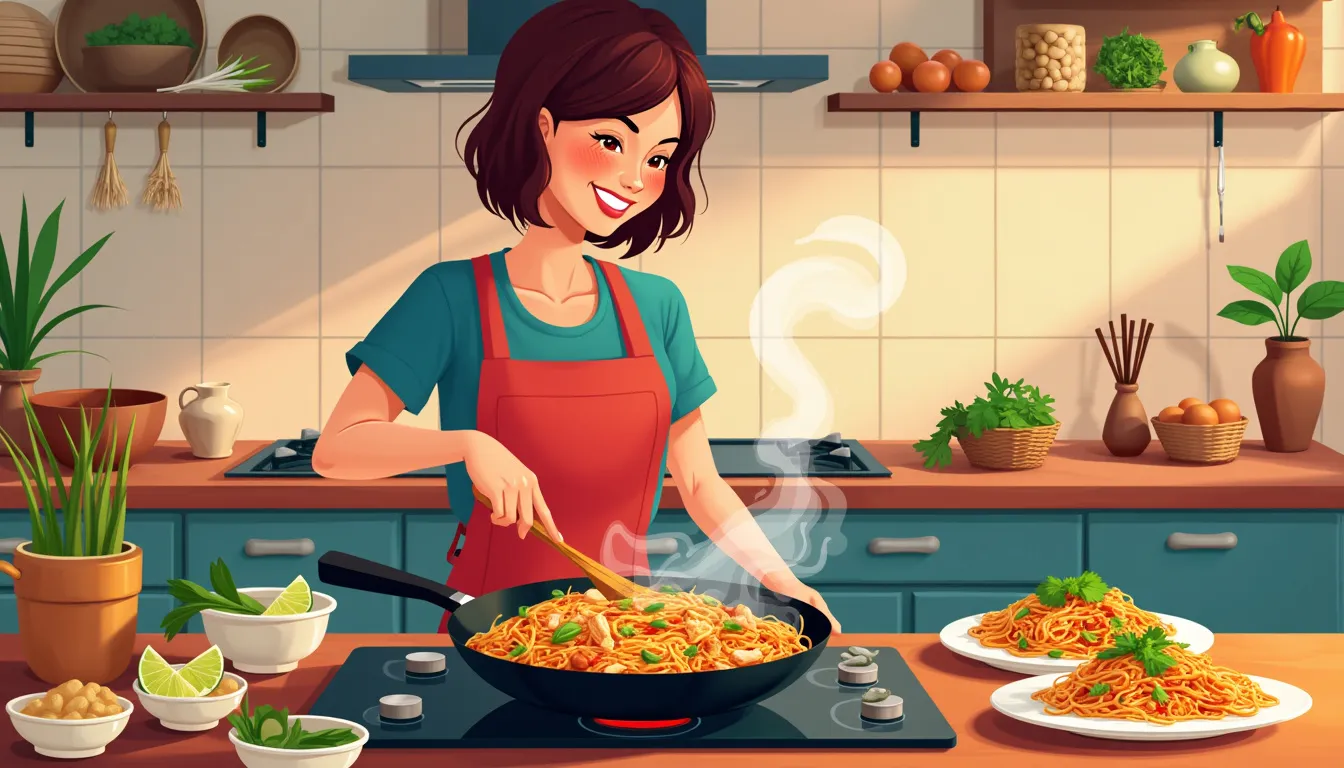Unlock the Secrets to Making Delicious Chicken Pad Thai at Home
Chicken Pad Thai is a popular Thai dish that has captured the hearts and taste buds of food enthusiasts worldwide. Imagine savoring the perfect combination of savory, sweet, and tangy flavors, intertwined with tender chicken and fresh vegetables—all in the comfort of your own kitchen. Whether you’re a seasoned cook or a beginner in the culinary arts, this guide will help you whip up the most delicious Chicken Pad Thai at home. By following these simple steps and tips, you can create an authentic Thai masterpiece that rivals your favorite restaurant’s version.
Our comprehensive guide is designed to walk you through each step, from gathering essential ingredients to mastering the cooking techniques that make Chicken Pad Thai so unique. With our focus on fresh ingredients, proper preparation, and expert cooking methods, you’ll soon discover just how easy and rewarding it can be to make this beloved dish from scratch.
Embark on this flavorful journey to better understand the crucial elements of Chicken Pad Thai, enhance your cooking skills, and impress your friends and family with your culinary prowess. Let’s dive into the world of Thai cuisine and uncover the secrets to creating the perfect Chicken Pad Thai at home.
Essential Ingredients for Authentic Chicken Pad Thai
Creating a delicious Chicken Pad Thai at home starts with the right ingredients. Knowing what to use and where to find these ingredients can make the difference between a good dish and a great one. Let’s dive into the crucial elements of pad thai and why fresh, quality ingredients matter.
Importance of Fresh Ingredients
Freshness is key in achieving the authentic flavors of chicken pad thai. Fresh ingredients not only enhance the taste but also ensure the dish’s nutritional value. Fresh vegetables provide a vibrant crunch, tender chicken delivers juicy protein, and freshly cooked rice noodles create the perfect foundation. Additionally, using fresh items like lime, garlic, and cilantro can add aromatic fragrances that elevate your pad thai to restaurant-quality levels.
Key Ingredients Overview: Rice Noodles, Chicken, Vegetables, and Sauces
A traditional Chicken Pad Thai consists of several core ingredients:
- Rice Noodles: These flat noodles are a staple in many Thai dishes. They absorb flavors well and have a pleasant chewy texture. Look for thin, flat rice noodles labeled for pad thai use.
- Chicken: Opt for boneless, skinless chicken breasts or thighs for easy preparation. Sliced into thin strips, the chicken should be tender and flavorful, soaking up the spices and sauces beautifully.
- Vegetables: Common vegetables in pad thai include bean sprouts, carrots, bell peppers, and green onions. You can customize with other veggies like broccoli or snap peas based on personal preference.
- Pad Thai Sauce: The heart of the dish. Traditional pad thai sauce is a balance of sweet, salty, and sour. It usually contains tamarind paste, fish sauce, lime juice, sugar, and a dash of chili pepper.
- Garnishes: Chopped peanuts, fresh cilantro, and lime wedges are typical garnishes that add crunch and fresh flavors to the finished dish.
Where to Source Specialty Ingredients
Many of the essential ingredients for authentic chicken pad thai may not be readily available at your local grocery store. Here are some tips on where to find these specialty items:
- Asian Markets: These stores are a treasure trove for hard-to-find ingredients like tamarind paste, fish sauce, and rice noodles. The variety and authenticity of products are often superior to those found in regular supermarkets.
- Online Retailers: Websites specializing in international foods can be a convenient option. They offer a wide range of imported goods, often with detailed descriptions and user reviews to guide your purchases.
- Health Food Stores: Establishments focusing on organic or specialty diets occasionally stock high-quality rice noodles and sauces free from preservatives and artificial additives.
- Produce Markets: Farmers’ markets or produce stands are excellent places to purchase fresh vegetables and herbs. Their direct-from-farm offerings ensure peak freshness and flavor.
By sourcing the freshest and most authentic ingredients, you ensure that your Chicken Pad Thai will not only be delicious but also true to its traditional roots. Combined with the right techniques, these ingredients can help you create a masterpiece that will impress any Thai food aficionado.
Step-by-Step Guide to Cooking Chicken Pad Thai
Preparing the Chicken and Noodles
One of the keys to making a mouth-watering Chicken Pad Thai is to ensure that every component is prepped and ready before you start cooking. Begin with the chicken; thinly slice boneless, skinless chicken breasts or thighs into bite-sized pieces. This helps the chicken cook quickly and absorb the flavors well. Season lightly with salt and a bit of pepper to get a head start on flavoring.
Next, focus on the noodles. Authentic Chicken Pad Thai uses flat rice noodles, which can be found in most Asian grocery stores or international aisles of larger supermarkets. Soak the rice noodles in warm water for about 20-30 minutes, or according to the package instructions. This will make them pliable and ready for quick stir-frying without becoming mushy.
Making the Pad Thai Sauce from Scratch
The soul of Chicken Pad Thai lies in its sauce. While pre-made sauces are available, making your own from scratch elevates the dish to new heights. You’ll need tamarind paste, fish sauce, palm sugar, and a bit of water. Tamarind paste gives the sauce its distinctive tangy flavor, while fish sauce adds depth and umami. Palm sugar sweetens the mixture, balancing out the tang and saltiness.
In a small bowl, combine 3 tablespoons of tamarind paste, 3 tablespoons of fish sauce, 3 tablespoons of palm sugar, and 1/4 cup of water. Stir until the palm sugar is fully dissolved. Some variations may include a teaspoon of soy sauce or rice vinegar to tweak the taste, but this basic combination captures the essence of traditional Pad Thai.
Cooking and Combining All Ingredients
Now that everything is prepped, it’s time to bring it all together. Heat a large wok or a deep skillet over medium-high heat and add 2 tablespoons of vegetable oil. Once the oil is hot, add the sliced chicken and cook until it’s fully done, which should take about 5-7 minutes. Remove the chicken from the wok and set it aside.
In the same wok, add a bit more oil if needed and toss in minced garlic (about 3 cloves) and chopped shallots (1 small). Sauté until they’re fragrant and begin to caramelize. Push the garlic and shallots to the side of the wok and crack two eggs into the center. Scramble the eggs until they are fully cooked, then mix them back in with the garlic and shallots.
Next, add the soaked rice noodles to the wok, followed by the prepared Pad Thai sauce. Stir continuously to ensure that the noodles absorb the sauce evenly. At this stage, you can also add the cooked chicken back to the wok along with some bean sprouts, sliced green onions, and grated carrots. Toss everything together and let it cook for another 3-4 minutes, ensuring that the ingredients are well-combined and heated through.
Finish by garnishing with chopped peanuts and a handful of fresh cilantro to give your Chicken Pad Thai that signature crunch and a burst of herbal freshness. Add a squeeze of lime on top for an extra zing and serve immediately.
With these step-by-step instructions, you can create a delectable Chicken Pad Thai that rivals any restaurant version right in your own kitchen. Whether it’s for a family dinner or entertaining guests, this dish is sure to impress and satisfy.
Tips and Tricks for Perfect Chicken Pad Thai Every Time
Making chicken pad thai at home can be both rewarding and delicious, especially when you’re equipped with the right tips and tricks. Understanding common pitfalls and knowing how to customize the recipe to fit different dietary needs will ensure your pad thai stands out. Let’s dive into some invaluable advice for achieving that flawless chicken pad thai experience.
Common Mistakes to Avoid
Even seasoned cooks can make mistakes when cooking chicken pad thai, so being aware of these can help you master the dish.
- Overcooking the Noodles: One of the most common mistakes is overcooking the rice noodles. They should be soaked in warm water until they are pliable but still firm, and then added to the stir-fry to finish cooking.
- Too Much Sauce: Adding too much sauce can turn your pad thai into a soggy mess. It’s better to start with less and add more as needed.
- Incorrect Cooking Heat: Stir-frying at too low a temperature can make the ingredients steam rather than fry, leading to a less flavorful dish. Always ensure your pan or wok is hot enough before adding the ingredients.
- Skipping the Tamarind: Tamarind paste is essential for authentic pad thai flavor. Skipping it or substituting with another sour ingredient can compromise the dish’s unique taste.
- Forgetting the Garnishes: Garnishes like crushed peanuts, lime wedges, and fresh cilantro not only add flavor but also give your pad thai a delightful finish.
Adjusting the Recipe for Different Dietary Needs
While traditional chicken pad thai is delicious, it’s also quite adaptable for various dietary preferences. Here’s how you can modify it to suit different needs:
Vegetarian or Vegan
To make vegetarian or vegan pad thai, simply swap the chicken with tofu or more vegetables. Use tofu that’s firm or extra-firm, and press it to remove excess moisture before cooking. Substitute fish sauce with soy sauce or a mix of soy sauce and a vegan fish sauce alternative.
Gluten-Free
Rice noodles are naturally gluten-free, but you’ll need to check that your soy sauce and other sauces don’t contain gluten. Tamari is a good gluten-free substitute for regular soy sauce. Additionally, avoid any pre-packaged pad thai sauce that contains gluten-based preservatives or additives.
Keto or Low-Carb
If you’re following a keto or low-carb diet, replace the rice noodles with zucchini noodles or shirataki noodles. Both alternatives work well to absorb the flavors of the sauce while keeping the dish low in carbohydrates.
Low-Sodium
To make a low-sodium version of chicken pad thai, use low-sodium soy sauce and reduce the amount of salt in the recipe. You can also rely more heavily on fresh herbs and citrus juice to bring in extra flavor without increasing the sodium content.
Serving Suggestions and Pairings
Presentation and complementary dishes can significantly enhance your chicken pad thai experience. Below are some serving suggestions and pairings that can add an extra layer of enjoyment to your meal:
- Garnishes: As mentioned earlier, garnishes are crucial. Offer bowls of crushed peanuts, lime wedges, fresh bean sprouts, chopped cilantro, and chili flakes on the side, so guests can customize their servings.
- Side Dishes: Pad thai pairs wonderfully with light and fresh sides. Consider a Thai cucumber salad, a simple green papaya salad, or steamed jasmine rice to complement the rich, savory flavors of the pad thai.
- Beverages: Thai iced tea is a classic beverage that pairs well with the complex flavors of chicken pad thai. Alternatively, a light beer, white wine, or even sparkling water with a splash of lime can be refreshingly complementary.
- Plating: Serve the pad thai in shallow, wide bowls to show off the array of ingredients. Arrange the chicken, noodles, and vegetables attractively, and add the garnishes for visual appeal.
- Condiments: Providing extra condiments like Sriracha sauce, fish sauce, and soy sauce allows each person to adjust the flavors to their liking.
Incorporating these tips and tricks will help you consistently prepare perfect chicken pad thai that impresses family and friends. Follow these guidelines, and you’ll soon be known for your exceptional pad thai skills!
Conclusion
Creating a delicious Chicken Pad Thai at home is not only a treat for your taste buds but also a rewarding culinary adventure. By focusing on fresh, high-quality ingredients and following the step-by-step guide, you can achieve restaurant-quality results in the comfort of your own kitchen. Remember to pay attention to common mistakes, like overcooking the noodles or chicken, to ensure a perfect dish every time.
Adjusting the recipe to fit different dietary needs is simple and allows you to cater to various preferences, making Chicken Pad Thai a versatile meal for any occasion. Whether you’re hosting a dinner party or preparing a quick meal for your family, this recipe is sure to impress. Pair it with complementary dishes and beverages to elevate your dining experience.
So, roll up your sleeves, gather your ingredients, and get ready to enjoy the delightful flavors of homemade Chicken Pad Thai. Bon appétit!







